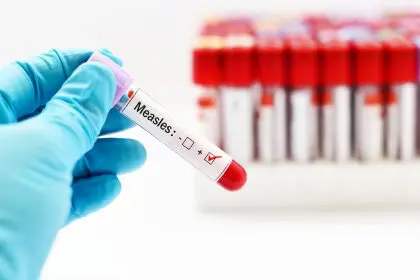A frightening new COVID variant is sweeping across America, bringing with it a horrifying symptom that victims describe as feeling like they’re swallowing broken glass. The strain, dubbed Nimbus, has health experts concerned as it rapidly becomes the dominant form of coronavirus in the United States.
What makes this variant particularly alarming isn’t just its rapid spread, but the excruciating throat pain it causes. People infected with Nimbus are reporting throat symptoms so severe they’re comparing it to having razor blades scraping down their throats with every swallow.
The pain is so intense that many sufferers are struggling to eat, drink, or even speak normally. Social media has been flooded with accounts from people describing the agony of this new symptom, with many saying it’s unlike any sore throat they’ve ever experienced.
What makes Nimbus different from other COVID variants
Nimbus, officially designated as NB.1.8.1, represents a significant evolution in how COVID affects the human body. While previous variants primarily targeted the respiratory system, this strain seems to have a particular affinity for throat tissues, causing inflammation and pain that goes far beyond typical cold or flu symptoms.
The variant’s rapid rise to prominence has caught many by surprise. In just a matter of weeks, Nimbus has gone from being virtually unknown to accounting for more than one-third of all COVID cases across the country. This explosive growth pattern suggests the variant may be more transmissible than its predecessors.
Health officials are monitoring the situation closely, as the speed of Nimbus’s spread indicates it may have developed new mechanisms for infection that make it more contagious than previous strains. The combination of increased transmissibility and severe symptoms is creating a perfect storm of concern among medical professionals.
The razor blade throat phenomenon explained
The signature symptom of the Nimbus variant has been dubbed “razor blade throat” for good reason. Those experiencing this condition describe an intense, sharp pain that occurs with every swallow, as if sharp objects are scraping against the delicate tissues of their throat.
Unlike typical sore throats that might feel scratchy or tender, this symptom is characterized by acute, stabbing sensations that can make even swallowing saliva an ordeal. Many patients report that the pain is so severe it disrupts their sleep and makes eating solid foods nearly impossible.
The mechanism behind this intense throat pain appears to be related to how the Nimbus variant attaches to and inflames throat tissues. The virus seems to cause more aggressive inflammation than previous variants, leading to swelling and sensitivity that creates the characteristic razor-like sensation.
Medical professionals are noting that this symptom often appears early in the infection process, sometimes even before other common COVID symptoms like fever or fatigue manifest. This early onset of severe throat pain may actually serve as an important warning sign for Nimbus infection.
How quickly Nimbus is spreading
The speed at which Nimbus has taken hold across America is nothing short of remarkable. Data tracking shows a dramatic surge in just a few short months, with the variant going from representing a tiny fraction of cases to becoming the dominant strain.
The rapid spread pattern suggests several concerning possibilities about Nimbus’s characteristics. The variant may have developed enhanced abilities to evade immune responses, allowing it to infect people who have been vaccinated or previously infected with other COVID strains.
Additionally, the severe throat symptoms may actually contribute to the variant’s spread. The intense pain and inflammation in the throat area could be creating conditions that make the virus more easily transmissible through respiratory droplets and aerosols.
Geographic data shows that Nimbus isn’t confined to specific regions but is spreading uniformly across different states and communities. This widespread distribution pattern indicates the variant has multiple introduction points and is being sustained by community transmission rather than isolated outbreaks.
Other symptoms accompanying razor blade throat
While the severe throat pain is the most distinctive feature of Nimbus infections, patients are reporting a constellation of other symptoms that accompany the razor blade sensation. These additional symptoms often develop alongside or shortly after the throat pain begins.
Fever remains a common symptom, though many Nimbus patients report that their fevers tend to be higher and more persistent than with previous COVID variants. Body aches and fatigue are also frequently reported, with many describing an overwhelming exhaustion that makes normal daily activities challenging.
Headaches appear to be particularly severe with Nimbus infections, with many patients describing them as more intense than typical COVID-related head pain. Some are also experiencing unusual symptoms like ear pain and jaw discomfort, which may be related to the intense throat inflammation.
Gastrointestinal symptoms, while less common, have been reported by some Nimbus patients. These include nausea, loss of appetite, and digestive discomfort, which may be partially related to the difficulty eating and drinking caused by the severe throat pain.
Who is most at risk
While Nimbus appears to be affecting people across all age groups and health statuses, certain populations may be experiencing more severe symptoms or higher infection rates. Understanding these risk patterns is crucial for protecting vulnerable individuals and communities.
Young adults and middle-aged individuals seem to be experiencing some of the most severe throat symptoms, contrary to patterns seen with earlier COVID variants where older adults typically had worse outcomes. This shift in symptom severity across age groups is puzzling medical experts and highlights how much this variant differs from its predecessors.
People with compromised immune systems continue to face elevated risks, as their bodies may struggle to mount effective responses against this new variant. Those with existing throat or respiratory conditions may find their symptoms particularly severe when infected with Nimbus.
Healthcare workers and others in high-exposure occupations are seeing increased infection rates, likely due to the variant’s enhanced transmissibility. The severe throat symptoms are creating additional challenges for these essential workers who need to be able to communicate clearly in their professional roles.
What to do if you develop razor blade throat
If you begin experiencing the characteristic severe throat pain associated with Nimbus, taking immediate action is crucial for your health and to prevent spreading the infection to others. The intensity of the pain should not be ignored or dismissed as a typical sore throat.
The first step is to isolate yourself from others, especially if the throat pain is accompanied by fever, body aches, or other COVID-like symptoms. Given how rapidly Nimbus spreads, early isolation can help protect family members and close contacts from infection.
Managing the severe throat pain requires a multi-pronged approach. Staying hydrated is essential, though this can be challenging when swallowing is painful. Sipping small amounts of cool liquids frequently may be more tolerable than trying to drink large quantities at once.
Over-the-counter pain relievers may provide some relief, though many Nimbus patients report that standard medications are less effective against this particular type of throat pain than they are for typical sore throats. Throat lozenges and warm salt water gargles may offer temporary comfort.
Treatment and management strategies
Managing a Nimbus infection requires a comprehensive approach that addresses both the severe throat symptoms and the overall viral infection. The intensity of the razor blade throat symptom often requires more aggressive symptom management than typical COVID cases.
Pain management becomes a primary concern with Nimbus infections. The severe throat pain can interfere with eating, drinking, and sleeping, which are all crucial for recovery. Finding effective ways to manage this pain while supporting the body’s immune response is essential.
Maintaining adequate nutrition and hydration poses unique challenges when swallowing is extremely painful. Soft, cool foods may be better tolerated than hot or rough-textured items. Smoothies, broths, and ice cream can provide both nutrition and soothing relief for the inflamed throat.
Rest becomes even more critical with Nimbus infections, as the combination of severe pain and viral illness can be particularly draining on the body’s resources. Creating a comfortable environment that supports both pain management and recovery is important for optimal outcomes.
Prevention strategies for Nimbus
Protecting yourself and your loved ones from Nimbus requires renewed vigilance and attention to proven prevention methods. The variant’s increased transmissibility means that standard precautions may need to be implemented more consistently and carefully.
Mask-wearing in crowded or indoor settings takes on added importance given Nimbus’s apparent enhanced ability to spread. High-quality masks that provide better filtration may be particularly valuable in high-risk situations or areas with significant community transmission.
Hand hygiene remains a cornerstone of prevention, as the virus can survive on surfaces and be transmitted through contact with contaminated objects. Regular handwashing and use of hand sanitizer can help reduce transmission risk.
Avoiding crowded indoor spaces when possible can help reduce exposure risk, especially in areas where Nimbus transmission rates are high. When indoor gatherings are necessary, ensuring good ventilation can help reduce the concentration of viral particles in the air.
The broader implications
The emergence of Nimbus and its distinctive razor blade throat symptom represents a significant development in the ongoing evolution of COVID-19. This variant’s characteristics suggest that the virus continues to adapt and change in ways that can surprise both medical professionals and the general public.
The severe throat symptoms associated with Nimbus are creating new challenges for healthcare systems that have been dealing with COVID for several years. Medical professionals are having to adapt their treatment approaches to address symptoms that are more severe than those typically associated with respiratory viruses.
The rapid spread of Nimbus also highlights the ongoing importance of surveillance and monitoring systems that can detect and track new variants as they emerge. Early identification of concerning variants allows for more effective public health responses and better preparation of healthcare systems.
Looking ahead
As Nimbus continues to spread and evolve, understanding its characteristics and symptoms becomes increasingly important for everyone. The razor blade throat symptom serves as a crucial warning sign that can help people identify infections early and take appropriate action.
The medical community continues to study this variant to better understand its mechanisms of infection, transmission patterns, and optimal treatment approaches. This ongoing research will be essential for developing more effective strategies for managing Nimbus infections and preventing their spread.
For individuals and families, staying informed about Nimbus symptoms and prevention strategies while maintaining access to healthcare resources remains the best approach for navigating this latest chapter in the COVID pandemic. The emergence of variants like Nimbus serves as a reminder that vigilance and adaptability continue to be essential tools in our collective response to this evolving health challenge.
















